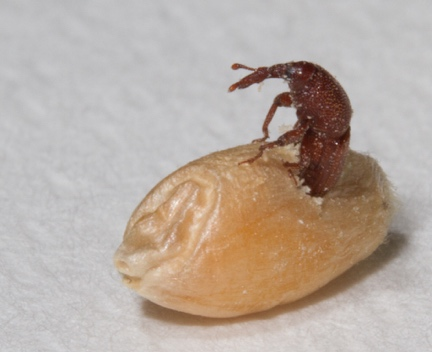Most insect pests thriving on nutritionally poor habitats have evolved obligate mutualistic relationships with heritable intracellular bacteria (endosymbionts) that supplement their diet with limiting nutrients and thereby improve their adaptive and invasive powers. The endosymbiont distribution is restricted to female germ cells and to the bacteriocytes, i.e. the specialized cells that seclude the bacteria and prevent their exposure to the host immune system. Remarkably, neither the host nor the endosymbiont can survive independently out of these integrated associations. Investigating the mechanisms by which insects maintain endosymbionts and control their number will participate to the identification of new specific targets of host-symbiont interaction and host homeostasis and fitness. By investigating the endosymbiotic association between the cereal weevil Sitophilus oryzae and the Gram-negative bacterium Sodalis pierantonius, we showed that bacteriocytes display a modulated expression of immune genes, notably marked by a down-regulation of most immune effectors, and that S. pierantonius undergoes a highly contrasted dynamics along the host life cycle. The endosymbionts load is controlled and adjusted to the host physiological and developmental needs through specific immune gene expression, cell apoptosis, and autophagy. The present project aims at unraveling the major host gene involved in the symbiosis homeostasis and endosymbiont dynamics, and at deciphering their mechanisms of regulation and function. We will decipher the molecular bases of the host-symbiont interactions at critical phases of the host development by using the dual-RNA-seq technology, which allows to simultaneously screen the transcriptomes of host and endosymbiont and to pinpoint their coordinated and contrasted gene expression. To go further into how the bacteriocyte immune response has evolved to express a limited set of immune effectors, and what are the regulatory elements behind this immunomodulation, we will identify cis-regulatory elements, non-coding RNAs, and candidate transcription factors acting as master regulators. Finally, we will analyze the function of selected candidate genes related to the bacteriocyte homeostasis or symbiosis dynamics during the host life cycle by combining complementary functional genomics tools, including in situ transcript and protein localization, RNA interference transcript inhibition, and structure-activity analysis of candidate proteins. By combining in silico and wet lab tools, we expect to provide a clear picture on the gene players and how they are regulated in both endosymbiosis homeostasis and along endosymbiont dynamics. We have the ambition to provide the foundation for identifying specific molecules disrupting the endosymbiotic relationship, as a novel control strategy for weevils and other major insect pests.



